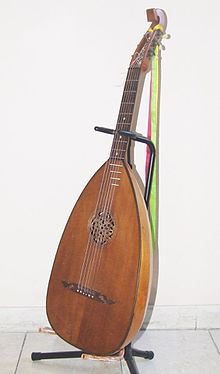Guitar lute
The lute guitar is a plucked string instrument from the family of shell neck loud . Other names for this instrument are German sounds (for the Waldzither used), hiking bird sounds , round sounds , sound guitar or Zupfgeige , even Bastard sounds . It trades as a folk instrument and as such was one of the most widespread musical instruments of the early 20th century in the German-speaking area and became a German national instrument .
history
Around 1800 the guitar took over the sixth string and tuning from the mandora , while the mandora took over the single strings from the guitar. The guitarized mandora was further developed into a new type of lute in the 19th century, which was more robustly built and provided with frets, mechanics and strings of the guitar, but retained the pear-shaped sound body of the lute. In simple terms, the guitar sounds can be regarded as sounds with “guitar strings”, from which their name is derived.
The guitar lute is strung like the classical guitar (six individual strings , usually in the guitar tuning EAdgh-e '). The strings are usually gut or nylon strings like on a concert guitar. Metal strings are rarely found in guitar lutes.
Designs
The body of the guitar lute has the typical teardrop shape of most lute instruments. The shell is composed of wood chips. A distinction is made between round bellied sounds with mostly 11 to 13 ribs and semicircular designs (Portuguese design) with a frame and 5 to 7 ribs. Flat-bellied sounds with a flat base plate also occur. Body wood is usually maple , and sometimes rosewood for high-quality round bellies . Almost exclusively spruce wood is used for the sound tops . Guitar lutes are almost exclusively made of solid wood. Blocked woods are only rarely used in frames with semicircular low-rise lutes.
The scale length of guitar lutes is usually around 620 mm. Most round abdominal sounds have a 9-flush sounds fingerboard , which lies in a plane with the sound-ceiling and continues on this 3 to 5 in corpus frets made of wood, metal or plastic. Especially with semicircular frame lutes, you can often find guitar-like fingerboards that extend on the sound cover to the sound hole. Both types of fingerboards can be flat or fluted. The fingerboard width at the saddle is usually 42 to 45 mm. Rosewood, ebony , but also local hardwoods ( walnut , oak ) are used.
The pegbox is not bent at a right angle as with a Renaissance lute, but runs straight. The trapezoidal pegbox adopted by Lute and Mandora is the most common design, window pegboxes similar to the guitar (but narrower) were used almost as often. One finds pegboards very rarely and mostly only on very old instruments. The guitar lute usually has tuning mechanisms , similar to the guitar, but wooden pegs are often used in trapezoidal peg boxes and pegboards . The pegbox mostly ends in a hook-shaped, rectangular, smooth or decorated plate or a carved head pointing forward.
As is customary with mandora and lute, the sound hole is made as a rosette . The variety of rosette motifs is legion. Classic ornamentation is just as common as floral design. Also figurative motifs, from depictions of flowers and animals to the “landscape with castle” testify to the taste of the times of the respective period of origin. With younger instruments or those manufactured in a factory, the soundhole rosette is often not carved out of the ceiling, but inserted.
A special form is the German bass lute or theorbed guitar lute , in which the pegbox is lengthened and a second pegbox is added to which so-called counter strings are attached (usually two to six).
use
Guitar lutes have been known mainly from German-speaking countries since the 19th century. In Germany in the early 20th century they were popular as a musical instrument among migrating birds and in the youth music movement . The instrument, colloquially called the plucked violin , probably also gave the famous songbook Der Zupfgeigenhansl its name.
Guitar sounds can be played like guitars, i.e. plucked or struck with your fingers or a plectrum . Today they are often used in the music of the Middle Ages because they are cheaper and more robust than historically oriented lutes , look more "historical" than conventional guitars and are easier to play than historically oriented lutes. While historically oriented sounds are mainly only suitable for chamber music due to their low volume (unless they are amplified with a microphone system), guitar sounds can also be used outdoors without amplification.
The guitar lute is often adorned with colorful fabric ribbons that are tied to the neck of the guitar. This accommodates a romanticizing idea of the Middle Ages , which was a characteristic of the youth movement and can still be found today in the Middle Ages market subculture and music scene.
See also
- Lautarre (another mixed form of lute and guitar from the 1970s)
literature
- Hans Dagobert Bruger (Ed.): School of lute play for the ordinary lute (bass lute), double-choir and theorbed lute. Taking into account the rules and experiences of the most famous lute masters of the 16th and subsequent centuries up to the present day. 2 volumes. Part 1: For the beginning student. Part 2: the artful Lautenschlager. Möseler Verlag, Wolfenbüttel / Zurich 1925.
- A. Pöhler: Die Klampfe: Songs for wandering birds and nesting birds. Conveniently positioned for the plucked fiddle . Berlin 1900 ISBN 495-2-118630
- Andreas Schlegel, Joachim Lüdtke: The Lute in Europe 2. The Lute Corner, Menziken 2006, ISBN 978-3-9523232-1-2



